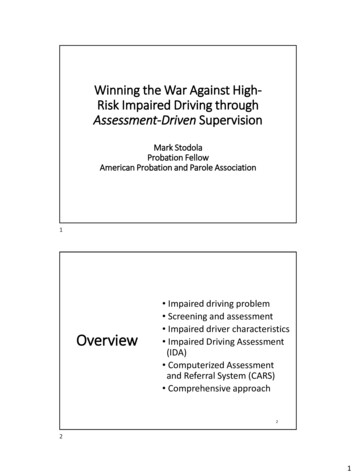
Transcription
Winning the War Against HighRisk Impaired Driving throughAssessment-Driven SupervisionMark StodolaProbation FellowAmerican Probation and Parole Association1Overview Impaired driving problem Screening and assessment Impaired driver characteristics Impaired Driving Assessment(IDA) Computerized Assessmentand Referral System (CARS) Comprehensive approach221
Drunk Driving bythe Numbers In 2018, there were one million drivers arrested for DUI. An alcohol-impaired driving fatality occurs every 48 minutes. In 2018, there were 10,511 alcohol-related traffic fatalities. 68% were in crashes where one driver had a BAC of .15 In 2018, the most frequently recorded BAC among drinking drivers in fatal crashes was.16 121 million drunk driving episodes occurred in 2016.342
Texas DWI FatalitiesAlcoholImpairedDrivingFatalities(BAC .08 %)1,480(40%)1,439(40%)5Fatalities in Crashes Involving an Alcohol-Impaired Driver(BAC .08 ) by County for 201863
Other Texas Statistics Alcohol related DWI Arrests- 69,643 10-year Change in Alcohol-Impaired Driving Fatalities per 100Kpop .08%, National average -8.4% Percent of Alcohol-Impaired Driving Fatalities Involving highBAC drive 72.9% 7DRUG-IMPAIRED DRIVING884
With impaired drivers, don’t assume!The drunk driver before you could actually be apolysubstance user.9What do DUIs look like in yourjurisdiction in 2020?105
4,600,000 individuals under community supervision in 201715% of this probation population have been convicted of DWIs8% of the probation population have been convicted ofmultiple DWIsApproximately two thirds of individuals under community supervision are drugor alcohol involved11Good News!!!Two Thirds of DWI Offenders self correct!12126
Approximately 25%of individualsarrested and 30% ofindividuals convictedof DUI are repeatoffenders.Contact with thecriminal justicesystem in and ofitself, does not deterat least 1/4 of alloffenders.1313Identifying thosemost at-risk14147
Criminogenic risk factorsHistory l/work1515Mental health?While not a criminogenic need, it is imperative that mental healthissues be identified and treated in order to adequately addressother risk factors.16168
SCREENING & ASSESSMENT1717Screening Screening is the first step in the process of determining whethera DUI offender should be referred for treatment. At this stage, offenders who do not have substance or mentalhealth issues are identified and those who may have issues canbe sent for a more in-depth assessment. Essentially, screening is a way to strategically target limitedresources by separating offenders into different categories (i.e.,those who do not have an alcohol/mental health problem andthose who likely do). The screening process in and of itself can also serve as a briefintervention as it requires the individual to begin to think abouttheir use patterns and whether they are problematic.18189
Screening - whoneeds furtherassessment?1919Whereshould wedevote ourresources?202010
Assessment After the screening process is completed, offenders whoshow signs of substance or mental health issues can bereferred for an assessment. An assessment tends to be more formal than screening andthese instruments are standardized, comprehensive, andexplore individual issues in-depth. In contrast with screening, a formal assessment processtakes longer to complete (it can take several hours) and istypically administered by a trained clinician or professional. This second step is meant to evaluate not only the presenceof a substance use disorder (alcohol and/or drugs) but itsextent and severity.2121Assessment Ideally, screening and assessment would occur at the beginningof the process (such as during the pre-trial stage). The results can then be used to inform: Sentencing decisions Case management plans Supervision levels Treatment referrals/plans It is important to note that assessments can be repeated atmultiple junctures throughout an offender’s involvement in thecriminal justice system to identify progress and to inform changesto existing plans as needed.222211
Post-arrestPre-trialAssessmentcan occur Community supervisionTreatment program2323Common assessment instrumentsAlcohol Dependence Scale (ADS)Risk and Needs Triage (RANT)Alcohol Severity Index (ASI)Correctional Offender Management Profile forAlternative Sanctions (COMPAS)Alcohol Use Disorder Identification Test (AUDIT)Ohio Risk Assessment System (ORAS)Inventory of Drug-Taking Situations (IDTS)Static Risk and Offender Needs Guide (STRONG)Drug Abuse Screening Test (DAST)Texas Risk Assessment System (TRAS)Michigan Alcoholism Screening Test (MAST)Level of Service Inventory-Revised (LSI-R)Substance Abuse Subtle Screening Inventory(SASSI)Adverse Childhood Experience (ACE)QuestionnaireResearch Institute on Addiction Self Inventory(RIASI)Trauma Symptom Inventory (TSI)242412
Limitations ofinstruments Majority of instruments are notdesigned for or validated among DUIoffender population. Using traditional assessments, DUIoffenders are commonly identified aslow risk due to a lack of criminogenicfactors. DUI offenders often have unique needsand are resistant to change on accountof limited insight. Recognition that specialized instrumentsshould be created to accurately assessrisk and needs of impaired drivers.25 Validated throughresearch Reliability;predictive value Standardized Appropriate for thetarget population Easy to useWhich instrumentshould I use? Informs decisionmaking Cost262613
Substance use disorders Rates of alcohol dependence increase and age of onset ofdependence decreases as number of DUI offenses increase(McCutcheon et al., 2009). 91% of male and 83% of female DUI offenders have met thecriteria for alcohol abuse or dependence at some point intheir lives (Lapham et al., 2000). In addition, 44% of men and 33% of women qualified forpast-year disorders.2727Substance use disorders Approximately 11-12% of impaired drivers are multipledrug users who report significant involvement in drugsother than alcohol or marijuana (Wanberg et al. 2005). 38% of male and 32% of female DUI offenders have metthe criteria for drug abuse or dependence at somepoint in their lives (Lapham et al., 2001).282814
Co-occurring disorders While research has shown that impaired driversfrequently have a substance use disorder, many of theseoffenders also have a psychiatric condition. The presence of a substance use disorder actuallyincreases an individual’s likelihood of having otherpsychiatric disorders. Co-occurring disorders are often difficult to diagnose assymptoms can be complex and the severity of thedisorders can vary.2929Co-occurring disorders In a study of repeat DUI offenders, it was found that 45% had alifetime major mental disorder. Another study (Shaffer et el. 2007) that examined the prevalence ofthese disorders by gender found that 50% of female drunkdrivers and 33% of male drunk drivers have at least onepsychiatric disorder. Mental health issues often linked to impaired driversinclude: Depression, bipolar disorder, conduct disorder,anxiety, anti-social personality disorder, andpost-traumatic stress disorder (PTSD).303015
The need for mental healthassessment among impaired drivers Very high level of psychiatric co-morbidity in DUI populations. Mental health issues linked to recidivism. Treatment has traditionally consisted of alcohol education orinterventions that focus solely on alcohol or substance use. Screening or assessment for mental health issues is not alwaysavailable/performed. DUI treatment providers rarely have the training/experienceto identify mental health issues among their clients.*Subsequently, in many cases, problems are not identified oraddressed3131DUI offenders areunique Often lack an extensive criminal history. High degree of denial: Drinking alcohol is not illegal, highly prevalent,and encouraged in society Tend to be employed and may have a stablesocial network Do not view themselves as criminals Repeatedly engage in behavior that is dangerous.Result DUI offenders tend to score lower on traditional riskassessments323216
ImpairedDrivingAssessment(IDA)3333Major Risk Areas of DUI Recidivism1. Prior involvement in the justice system specificallyrelated to impaired driving2. Prior non-DWI involvement in the justice system3. Prior involvement with alcohol and other drugs(AOD)4. Mental health and mood adjustment problems5. Resistance to and non-compliance with current andpast involvement in the justice system343417
Goals of IDA1. Provide guidelines for identifying effective interventionsand supervision approaches that reduce the risk ofnegative outcomes in treatment and communitysupervision.2. Provide preliminary guidelines for service needs for DUIclients.3. Estimate the level of responsivity of clients to supervisionand to DUI and AOD education and treatment services.4. Identify the degree to which the client’s DUI hasjeopardized traffic safety and to address this in thesupervision plan.3535IDA ComponentsSelf-Report (SR)Evaluator Report (ER)34 questions11 questions Mental health andmood adjustment; AOD involvement anddisruption; Social and legal nonconformity; and Acknowledgment ofproblem behaviorsand motivation toseek help for theseproblems. Past DWI/non-DWIinvolvement in judicialsystem; Prior education andtreatment episodes; Past response to DWIeducation and/ortreatment; and Current supervision andservices status.3618
PSYCHOSOCIALItems 1-8AOD INVOLVEMENTItems 9-17LEGAL NON-CONFORMITYItems 18-25ACCEPTANCE/MOTIVATIONItems 26-29, 32, 34DEFENSIVENESSReverse-Scored 13 SR ItemsSR GENERAL23 SR ItemsER GENERAL9 ER ItemsDWI RISK-SUPERVISION ESTIMATE31 SR and ER Items, Age, Marital37ConvergentValidationModelCLIENT Estimate “true”condition Generate baselineestimate of selfperception Measure willingnessto discloseRECORD Cross-validate client’sself-report informationBESTESTIMATE Estimate defensivenessand willingness todisclose3819
Self-report questions (e.g.)Do you have up ordown moods?How many timeshave you receivedtreatment formental/emotionalproblems?Do you getnervous, tense, orworry aboutthings?How many timesin your life haveyou been drunk orintoxicated onalcohol?How serious of aproblem is yourDWI for you?3939Evaluator report (e.g.) # of non-DWI involvements with criminal justicesystem # of DWI/AOD education program episodes # of treatment program episodes Past interlock use Past electronic monitoring use Level of supervision, treatment,and expected compliance404020
41Interpretation of Risk/Needs Areas Scored “high-medium” to “high” on first three scales Scored “high” on acceptance/motivation and “low” on defensivenessscales SR General and ER General raw scores are in the same decile rank range Scored “high” on DRSE scale4221
Case Example Recommendations More extensive evaluation in areas of psychosocial, AOD use, andillegal conduct Benefit from higher levels of supervision and AOD treatment Relapse preventionCBT to manage high risk situationsInterlock deviceRandom drug tests43Utilization and guidelines1. What are we trying to accomplish? Estimate the probability of negative outcomes and to re-offend Estimate of supervision and service needs2. Does the IDA only estimate risk? Includes a resource for estimating service needs, responsivity tointerventions, and traffic safety3. Should assessment be an evolving process? IDA is an initial screener, yet provides guidelines to proceed Need more comprehensive assessment4. Should the IDA be used as a sole basis for making decisions? All sources of information are to be used―client/record Final decisions are made by the evaluator and/or court444422
FAQ’sHow much of my life will I have to burn conducting theIDA?Does the IDA need to be conducted more than once?Is it better to use the IDA at pre-sentence or postsentence?Why are some IDA questions asking about recentexperience while others ask about lifetime?45FAQ’sWhat if our state is already required to use anassessment tool? Which score do I go with?What if I suspect my client is not answering SRquestions honestly?Can’t I let my client complete the self report athome?Will the IDA give specific information on treatmentreferrals?4623
FAQ’sIs giving feedback to my client that important?Please tell me this is the only assessment tool I willhave to use!What are the training options for my jurisdictions?47Does the IDA replace the PO?4824
Online training is -G.aspx49ComputerizedAssessmentand ReferralSystem5025
Development of CARS CARS was developed by a team of researchers fromCambridge Health Alliance, a teaching affiliate of HarvardMedical School. Initial grant funding was provided by NIAAA; Responsibility.orgcontinues to fund CARS research and implementation. The goal was to create an assessment tool specifically for aDUI offender population that fills the mental health voidthat exists with traditional instruments.5151525226
What is 353What is CARS? Diagnostic report generator that gives providers and clients: Immediate diagnostic information for up to 20 DSM-V Axis Idisorders (onset, recency, persistence). Geographically and individually targeted referrals totreatment services based on the outcomes of l healthissues545427
How does CARS work? CARS is a completely electronic assessment tool. It isavailable as free open source software. There are three versions of the CARS tool that can be used: Full assessment Screener Self-administered screener CARS is divided into modules representing various mentaldisorders and psychosocial factors. The individual administering CARS can select any subset ofmodules. There is the ability to choose from a past 12-month orlifetime version of the questions for each disorder.5555CARS comprehensive mental health screener domainsPanic disorderSocial phobiaEating disordersAttention deficit/hyperactivitydisorderObsessive compulsivedisorderDepressionGeneralized anxietySuicidalityMania/bipolar disorderPost-traumatic stress disorderConduct disorderOppositional defiant disorderPsychosisNicotine dependenceAlcohol use disorderDrug use disorderGambling disorderPsychosocial stressorsDUI/criminal behaviorIntermittent explosivedisorder565628
How does CARS work?5757How does CARS work? Individual diagnostic reports have been programmed toprovide information about the mental health disorders forwhich a person qualifies or is at risk, as well as a summaryof bio-psycho-social risk factors. The CARS tool includes a section on DUI behavior. The data obtained from the questions in this section isintegrated with other risk factors to generate an overall DUIrecidivism risk score. A graphic is generated as part of theoutcomes report that indicates wherean individual is within a range of lowto very high risk.585829
CARS report5959CARS report606030
Bridging the gap Unlike traditional assessments, CARShas a built-in referral system. CARS has been designed to include alist of individually-targeted referrals atthe end of each report based on anindividual’s issues and zip code. Before CARS can be implemented, thereferral list must be populated withtreatment services that are availablewithin that jurisdiction.61Benefits of CARS Provides immediate diagnostic information for up to 20major psychiatric disorders. Provides geographically and individually targeted referralsto appropriate treatment services. Generates user-friendly reports at the click of a button. Informs supervision and treatment decisions. Runs on free open source software. Can be used by non-clinicians. Applicable in a number of settings.626231
National roll-out CARS was launched for general use in June 2017. Available to any court, probation department, or programfree of cost. Online web portal for downloads and ons for building yourcase plan What are your resources? What is your response to risk? Does your client know his assessment results? Use the IDA in addition to your generic assessmenttool.646432
ASSESSMENT IS ONGOING & DYNAMIC6565Utilize all tools available Screening/assessment for substance use and mental healthdisorders Refer to appropriate treatment interventions that are tailored toindividuals’ risk level and specific needs Treat co-occurring disorders concurrently Use technology to monitor compliance and progress (e.g.,ignition interlocks, continuous alcohol monitoring, random drugtesting, etc.) Hold offenders accountable for non-compliance Apply swift, certain, and meaningful sanctions666633
Individualize justice Understand that there is more to the offending than justdriving drunk. Avoid judgments and focus on the individual; there is no onesize-fits-all model for supervision and treatment. Respect for the individual coupled with accountability. Utilize a comprehensive approach that addresses individualrisk factors and treatment needs.6767Mark StodolaProbation FellowAmerican Probation and Parole AssociationProbationfellow@csg.org(602) 402-0523686834
Assessment (IDA) 33 Major Risk Areas of DUI Recidivism 1. Prior involvement in the justice system specifically related to impaired driving 2. Prior non-DWI involvement in the justice system 3. Prior involvement with alcohol and other drugs (AOD) 4. Mental health and mood adjustment problems 5. Resistance to and non-compliance with current and











